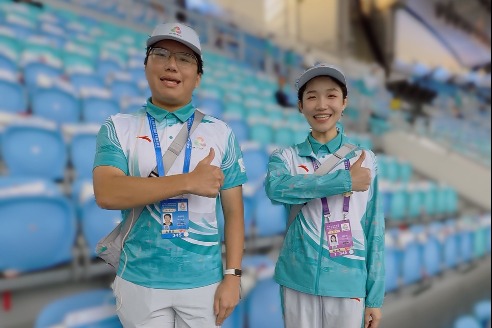PLA Air Force marks 76th anniversary with more advanced, intelligent equipment

BEIJING -- The People's Liberation Army Air Force marked its 76th anniversary on Tuesday. From humble beginnings, it has evolved into a modern force equipped with some of the world's leading aircraft, with a growing emphasis on intelligent, information-driven capabilities.
On Tuesday, the PLAAF released a 26-minute microfilm on its official social media accounts to mark the anniversary, named Dreaming Far. The film presents the progress of the Air Force from the perspective of an ordinary family living next to an airport, with a few seconds of images showcasing a large drone codenamed Xuanlong-08.
In the film, Xuanlong-08 forms a three-aircraft formation with two manned fighter jets, a J-16, and a J-20 codenamed Weilong-1, while the pilot of the J-20 said that the drone has teamed up with his fighter as a loyal wingman.
It is the first time that the PLAAF has published the footage of manned and unmanned aircraft teaming up, which quickly captured nationwide attention and generated thousands of comments online.
"In the past, we looked to foreign forces for advanced weapons and equipment. Now we look to our own," read one proud comment under the film.
"Though the dream may seem distant, persistent effort will ultimately bring it to fruition," read another comment.
Another microfilm, which was published on the social media account of the military channel of CCTV, China's national broadcaster, reviewed the history of the PLAAF with interviews with pilots from different generations, showcasing the country's fighter jets from first-generation J-5 to the fifth-generation J-20 and the latest J-35, as well as the large transport aircraft Y-20B.
"We have the best aircraft. Our hands can wield either a rifle or an olive branch," said a pilot named Chen Siqi in the microfilm.
Founded on Nov. 11, 1949, the PLAAF started with only a handful of outdated planes. During the founding ceremony of the People's Republic of China on Oct. 1, 1949, only 17 aircraft were available for inspection.
Later, during the War to Resist U.S. Aggression and Aid Korea (1950-1953), the young air force shot down or damaged 425 enemy aircraft.
Over the past more than seven decades, the PLAAF has achieved a historic transformation from mechanization to informatization, and from an air defense force to one capable of both offensive and defensive operations.
Advancing technology continuously reshapes warfare, and keeping pace with these shifts is key to winning future battles.
China's top leadership in October adopted its recommendations for formulating the country's development priorities for the next five years. For the military, it calls for stepping up the development and utilization of data resources, so as to develop an intelligent military system.
In the PLAAF, AI has become a new tool to hone pilots' skills. In a simulated air combat against AI, Ma Xiao, an outstanding pilot with experience flying five types of fighter jets, faced unprecedented challenges.
"It is very aggressive and never makes mistakes," Ma commented on his new adversary. This AI air combat system absorbs the strengths of all pilots in Ma's brigade and gradually evolves into an "all-around" adversary.
With AI's assistance, pilots of the brigade have achieved breakthroughs in real-combat-oriented training and made remarkable progress in flight skills.
"We must study not only the wars of today but also the wars of the future," said the commander of the brigade.
- PLA Air Force marks 76th anniversary with more advanced, intelligent equipment
- Benefits of reunification envisioned
- Postgrad uses social media to construct 'bridge for dialogue'
- Chinese doctors' newspaper column helps raise health awareness in PNG
- Modern caravans improve herders' mobility
- Calls and conservation





































